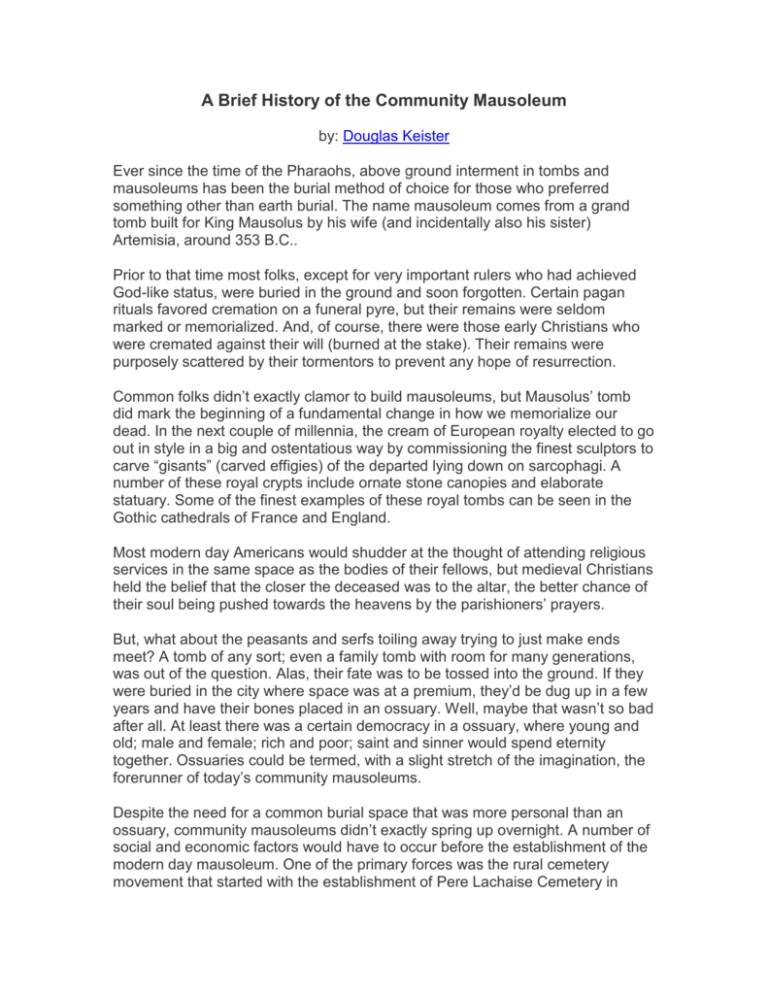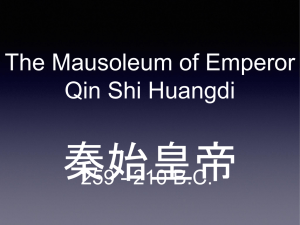
A Brief History of the Community Mausoleum
by: Douglas Keister
Ever since the time of the Pharaohs, above ground interment in tombs and
mausoleums has been the burial method of choice for those who preferred
something other than earth burial. The name mausoleum comes from a grand
tomb built for King Mausolus by his wife (and incidentally also his sister)
Artemisia, around 353 B.C..
Prior to that time most folks, except for very important rulers who had achieved
God-like status, were buried in the ground and soon forgotten. Certain pagan
rituals favored cremation on a funeral pyre, but their remains were seldom
marked or memorialized. And, of course, there were those early Christians who
were cremated against their will (burned at the stake). Their remains were
purposely scattered by their tormentors to prevent any hope of resurrection.
Common folks didn’t exactly clamor to build mausoleums, but Mausolus’ tomb
did mark the beginning of a fundamental change in how we memorialize our
dead. In the next couple of millennia, the cream of European royalty elected to go
out in style in a big and ostentatious way by commissioning the finest sculptors to
carve “gisants” (carved effigies) of the departed lying down on sarcophagi. A
number of these royal crypts include ornate stone canopies and elaborate
statuary. Some of the finest examples of these royal tombs can be seen in the
Gothic cathedrals of France and England.
Most modern day Americans would shudder at the thought of attending religious
services in the same space as the bodies of their fellows, but medieval Christians
held the belief that the closer the deceased was to the altar, the better chance of
their soul being pushed towards the heavens by the parishioners’ prayers.
But, what about the peasants and serfs toiling away trying to just make ends
meet? A tomb of any sort; even a family tomb with room for many generations,
was out of the question. Alas, their fate was to be tossed into the ground. If they
were buried in the city where space was at a premium, they’d be dug up in a few
years and have their bones placed in an ossuary. Well, maybe that wasn’t so bad
after all. At least there was a certain democracy in a ossuary, where young and
old; male and female; rich and poor; saint and sinner would spend eternity
together. Ossuaries could be termed, with a slight stretch of the imagination, the
forerunner of today’s community mausoleums.
Despite the need for a common burial space that was more personal than an
ossuary, community mausoleums didn’t exactly spring up overnight. A number of
social and economic factors would have to occur before the establishment of the
modern day mausoleum. One of the primary forces was the rural cemetery
movement that started with the establishment of Pere Lachaise Cemetery in
Paris in 1804. Cemeteries would now have acres and acres of land available for
all sorts of fanciful tombs and monuments. After all, what good is a mausoleum
without some place to put it?
Another factor was Queen Victoria, who after the death of her beloved Albert, in
1861, went on a veritable mourning frenzy. Victoria led the way in making
memorialization fashionable. Cemeteries were not only a pleasant respite from
the dirty and noisy cities; they also became large scale public art galleries. While
a family grieved over the loss of a loved one, they could absorb a little culture.
Most importantly (for the establishment of the community mausoleum) were the
folks in Spain who figured out a way to make above ground burial affordable to
the masses. Examples of their tidy invention, wall vaults (also known as oven
vaults and side vaults), may be seen in the cemeteries of New Orleans. Society
tombs expand the idea of wall vaults. These tombs, composed of multiple crypts,
were built by fraternal organizations, such as the Elks or other “protective and
benevolent associations”.
Members of these organizations were assured of an above ground burial spot,
just like today’s community mausoleums. The chief difference is that while a slot
in a community mausoleum is a permanent affair, one’s stay in a society tomb
was usually brief. There were far more members of a society than crypts in the
tomb. After a proscribed amount of time, the bones of the dear departed would
be swept up and placed in an ossuary.
It wasn’t until the 1870’s that there was much interest in America in community
mausoleums. The rural cemeteries that had sprung up outside most American
cities were rapidly becoming sculptural and architectural wonderlands, filled with
elegant private mausoleums and artistic statuary. The time was ripe to offer
above ground burial to the masses. Cemetery promoters touted above ground
burial as aesthetically pleasing and much easier on the grieving family than
having shovelfuls of dirt tossed on their loved ones’ remains.
Unfortunately, some of the first community mausoleums suffered from shoddy
construction and much of the profit realized by the cemetery from the sale of the
crypts was soon eaten up by maintenance costs. Nevertheless, cemeteries
continued to construct community mausoleums, but with improved construction
techniques that lowered maintenance costs. The introduction of the outdoor
garden crypt in the 1920’s lowered costs even more—indoor crypts, frequently in
a building that also housed a chapel, had to be heated, adding substantial cost in
cold climates.
Ironically, the end of the Golden Age of the private mausoleum in the 1920’s
spurred community mausoleum sales even more. Those who could not afford a
private mausoleum due to hard economic times (the advent of the income tax
and the Great Depression), turned to the community mausoleum as a second
choice for the above ground burial they preferred.
One of the most ambitious community mausoleum projects, and the world’s
largest Catholic mausoleum, is Chicago’s Queen of Heaven mausoleum
complex. The project was launched in 1954 with an appeal by Cardinal Samuel
Sritch to Chicago area Catholicsto “purchase a crypt now” and help fund the
construction of the mausoleum . Chicago’s Catholics responded in remarkable
numbers and the Queen of Heaven mausoleum was completed by 1956.
By 1961, a new section, Queen of Angels was added and in 1964, the final
section, Queen of All Saints completed the indoor necropolis. The Queen of
Heaven triplex mausoleum complex has room for over 33,000 bodies and is
about 75% filled. A stunning array of stained glass, statuary and exotic woods
greet visitors to Queen of Heaven. The complex also includes a chapel, with
crypts lining the the apse and gallery areas giving the chapel area the feel of a
modern day version of a European Gothic cathedral.
If one is looking for an example of a sleek and efficient 20th century community
mausoleum, take a peek at the 30,000 crypt Sunset Mission Mausoleum at
Inglewood Park Cemetery in Los Angeles. The mausoleum is being constructed
in five stages. In addition to the above ground crypts and cremation niches the
mausoleum also contains non-visitation underground crypts. Occupants of the
underground crypts are memorialized with bronze plaques placed on curving
marble walls directly above the crypts.
Inglewood Park Cemetery currently has over 90,000 mausoleum spaces on its
350 acres, with plans to build even more. The cemetery also has a large
scattering garden and thousands of cremation niches designed to accommodate
the high cremation rate (approximately 50%) in California.
Despite the rise in cremation, modern day cemeterians report steady sales of
community mausoleum crypts. Frank Hegner, President of Fairmount Cemetery,
in Denver reports that 14,000 of their 125,000 burials are in above ground crypts.
“We still have about 28 acres of undeveloped land in our 106 year old cemetery.”
Says Hegner. “We plan on developing space on that land for a community
mausoleum to accommodate some of our 1000 interments a year.” Above
ground burial in the form of garden crypts, cremation niches and a scattering
garden helps alleviate some of the space problems in historic Mount Auburn
Cemetery outside Boston.
Established in 1831, as the first “garden cemetery” in the United States, there is,
understandably, very little space left for burials. Mount Auburn’s board of
directors see their prime mission as the maintenance of the landscape and the
preservation of the historic cemetery. The garden crypts at Mount Auburn fit well
into the landscape and help to keep the cemetery an active burial ground.
Robert Keller, Assistant Director of Sales and Administration at Mount Auburn
notes, “About 10% of our sales are for space in the garden crypts, but those
sales represent about 20% of our income. The majority of the crypts are
purchased by Italian-Americans, who have a strong tradition of memorialization
and above ground burial”. “Not surprisingly”, he continued, “we’ve noticed that
crypts at eye level sell first; then those above eye level, followed by crypts on the
lower tier. Companion crypts sell quite well. But with the changing social
structure in America, we’ve noticed an increase in the number of single crypts
sold.”
In New Orleans, the tradition of above ground burial was established near the
end of the eighteenth century. The Governor of Louisiana was from Spain and
his Spanish/European influence was felt at all levels of New Orleans society,
including the funerary arts. At the time, in Spain, it was fashionable to be buried
above ground, and New Orleanians, despite the fact that they were on the edge
of the frontier of the New World, wanted to adopt current trends and fashions.
Folklore suggests that burials were above ground due to the high water table, but
the tradition has more to due with style than practicality.
It’s quite understandable that at New Orleans’ Metairie Cemetery, owned by
Stewart Enterprises, above ground burial constitutes approximately 90% of
interments. The change at Metairie in the last few decades has been away from
the family mausoleums and towards community mausoleums. In August 1997,
the 862 space Oaks mausoleum opened and plans are already underway to build
a 1000 crypt mausoleum.
Apparently, the rise in cremation has had little negative effect on community, or
for that matter, private mausoleum sales. Mausoleum contractors and
manufacturers report strong sales, which they expect will continue well into the
next century.
About the author: Douglas writes articles for American Cemetery Magazine,
and has written a book on the history of the mausoleum called Going Out in
Style: The Architecture of Eternity. You can look at some of his work at his web
site, Douglas Keister Photography.
Copyright � 1999 Douglas Keister All rights reserved. This article is being reprinted on this site
with permission from the author.








